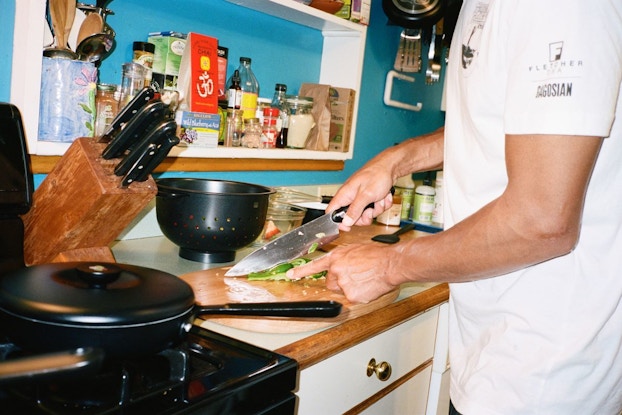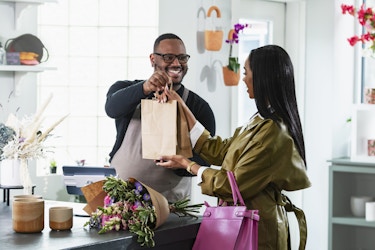
Sweetgreen salad bars, Recess sparking water, Harry’s shavers: Chances are, if you’ve followed developments in the direct-to-consumer space over the past decade, you’re familiar with the work of branding agency Gin Lane.
With a proven track record of developing successful brand identities, co-founders Nick Ling and Emmett Shine wanted to put their millennial marketing mastery to the test in a situation where they would have more control over both the implementation and sustaining of the brand. In August 2019, Gin Lane announced it would be reborn as Pattern Brands, forgoing its client work in order to develop and sell its own products.
Pattern is, essentially, a direct-to-consumer (DTC) holding company. Rather than acquire existing companies, Pattern will develop and bring to market its own lifestyle brands, maintaining a direct relationship with the customer along the way. Under its umbrella thus far are Equal Parts, offering cookware and kitchen accessories, and Open Spaces, a design-led, minimalist twist on home organization.
Ling, who serves as the chief executive to Shine’s executive creative director, tells CO— the transition from Gin Lane to Pattern has been relatively smooth. “The day-to-day is very similar,” he said, “but now there’s a much clearer mission.” The operating principle of Pattern’s brands is giving people the products and the guidance to build better habits and create a haven out of the home — even if it’s just a small apartment, Ling said.
Creating havens for the housebound
Pattern’s commitment to the home is one that has served the company in the wake of COVID-19, amid a newfound focus on just about everything that can be done without leaving the house.
“We’re in the fortunate position to still be operating as normally as possible and want to help others who may not be,” Ling wrote in a statement one month into near nationwide lockdown. “At Pattern, we've always viewed our home as a haven, and we're finding our mission to help people create space in their lives and homes for newfound hobbies is resonating now more than ever.”
Each of Pattern’s sub-brands is offering complimentary resources to support their customers as they embark on new projects or set out to build new habits. For example, Open Spaces customers have free access to a professional organizer, who can answer questions and give suggestions about how to turn their home into a sanctuary at this time. Equal Parts connects its followers with live, digital cooking workshops and a free hotline for all questions related to food and cooking.
What we’ve seen so far is really just the tip of the iceberg in terms of changing consumer behavior and spending over the next decade.Nick Ling, co-founder and CEO, Pattern Brands
Pivot
Pattern Brands is catering its focus to the nationwide moment of staying home. If you're considering a pivot to your own business, read on for more current trends.
Building a more sustainable brand ecosystem
In transforming from a branding agency to a holding company, Pattern chose an umbrella-company model to mitigate the pressures DTC brands face when they take on outside funding to reach scale. “We’re building what we call a multi brand model because we don't want to grow our brands larger than they need to be,” Ling told CO—. “What’s really important to us is that [the business reflects] a set of brands that are designed to work together, versus being a collection of random ideas.”
Ling describes Pattern’s new take on DTC as a design-led, “direct-with-consumer” model. This flexibility allows for Pattern to evolve along with a new generation of home goods consumers, in the hopes of creating a more sustainable business.
So far, Ling is inspired by the new challenges brought on by the pivot. “What’s been really cool,” he said, “is that during that transition, we’ve had to bring a lot of skill sets in-house that used to be external to us, like supply chain and logistics or growth marketing.”
Most of the Gin Lane team moved to Pattern, and the staff has since grown as the company takes on new capabilities. Before Equal Parts’ official launch, Pattern raised several rounds of VC funding for a reported total of $30 million.
Ling muses that the retail sector is nearing the end of an era in which brand building strategies were often one size fits all. “I’m very excited that we’re getting a lot more diversity in what types of brands are built and how,” he said. “What we’ve seen so far is really just the tip of the iceberg in terms of changing consumer behavior and spending over the next decade.”
'We want to make sure our brands reflect the values of our generation’
Despite younger consumers renting longer and owning homes in lower numbers than Gen X at the same age, they’re still finding ways to invest in their living spaces.
Aging into increased spending power and out of their twenties, many millennials are finding sanctuary in the home, a place to escape the office or the internet. According to a study by Mintel, 28% of millennials prefer to stay in because “going out is too much effort,” compared to only 15% of boomers who said the same.
Companies like Pattern have cropped up to fill this need, delivering higher-end but accessibly priced bedding, cookware and furniture designed to keep for longer than a year’s lease. After purchasing pots, pans and utensils from Equal Parts, customers are then invited to keep in touch via a “Text A Chef” service that helps find recipes and plan meals.
Ling is tapping into more than a demographic opportunity — he’s also drawing from his own personal experience, he said. In his mid-30s and preparing for a wedding later this year, his own priorities as a consumer are more domestic than ever. “Pattern represents our thinking through what we want that next phase in our life to look like,” he said, “and pushing back on some of the things that have maybe dominated our lives a little too much, like technology or social media.”

DTC kitchen competition heats up
Making good design and quality products accessible to the average millennial is the cornerstone of Pattern’s brand-building strategy. Products are conceived to be minimalist and Instagrammable, to differentiate from existing brands in the sometimes staid and often cost-prohibitive home cooking and organization categories. But Pattern is not the only one with this idea.
A batch of newbie DTC home brands are vying for the same space.
“Social media has enabled these companies to establish direct connections with consumers,” Cristina Fernandez, director and senior researcher with Telsey Advisory Group, told CO—. However, she adds, “the field is becoming crowded.” An abundance of DTC, VC-funded brands continues to drive customer acquisition costs sky high.
Indeed, Equal Parts faces some stiff competition in the buzzy cookware space in particular. Brands like Great Jones,Caraway, Our Place, Made In,Sardel and more are all jockeying for the same space in the cabinets of young consumers. Though each brand is relying on sleek design and an authentically millennial voice to connect with its users, mainstream success may just come down to who offers the best product for the best value.
“Consumers today are more conscious about what they buy,” Fernandez said. “The internet has provided great price transparency to consumers, and they are more savvy as to how much they should pay for a product.” Put simply, “consumers are looking for good value.”
There is also, of course, the possibility that legacy brands will simply mimic these same qualities, as they have following the “disruption” of other categories such as activewear, mattresses and sustainable sneakers.
In the future, Pattern’s leaders predict Equal Parts, Open Spaces and future brands will reach new customers through many channels, rather than rely on the Instagram-to-e-commerce pipeline. “We’ve launched our brands online first because it’s the way that’s easiest to reach consumers,” Ling said, “but we believe we need to be in physical retail.”
Fernandez agreed. “Many DTC brands find that they need to showcase their product in a physical space to get greater scale.” What’s more, brick-and-mortar retail is an opportunity to “show the product attributes, attract new customers and create communities,” she said.
That relationship with the customer will be key as Pattern’s brands develop, creating a feedback loop that will, in theory, inform better product and retail experiences.
Avoiding presupposing too much about the future, Ling does believe that Pattern will be flexible enough to evolve along with systemic disruptions and shifts in customer demand.
Ultimately, he said, “it’s our goal to continue being a resource for our community during this time, when shaping a home and building sustainable habits you can enjoy in your space is paramount.”
CO— aims to bring you inspiration from leading respected experts. However, before making any business decision, you should consult a professional who can advise you based on your individual situation.
Want to read more? Be sure to follow us on LinkedIn!
CO—is committed to helping you start, run and grow your small business. Learn more about the benefits of small business membership in the U.S. Chamber of Commerce, here.







